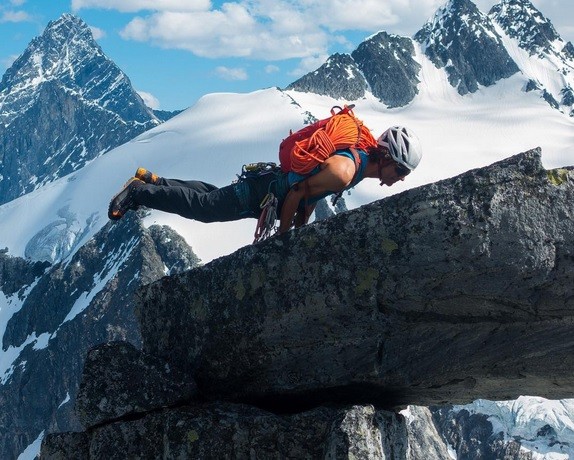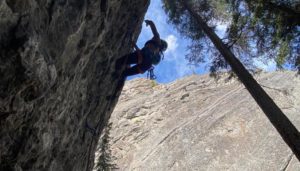How Climbers Can Avoid the Dreaded Hunchback

There are a number of reasons climbers might end up with rounded upper back, hunched shoulders and ultimately a hunchback resembling the ogre of Notre Dame.
Climbing provides a rigorous workout for the pull muscles, but demands much less of the opposing push muscles of the chest (specifically the pectoral muscles), shoulders, and upper arms.
In the long term this could lead to overdeveloped back muscles (a hunch) or injuries, as these stabilizing push muscles may fall out of balance with their opposing pull muscles.
The primary muscle used while you climb is your lats (or latissimus dorsi.) This muscle, located along the sides of your back is “wing shaped” and allows you to pull down. When you climb, you are constantly pulling and building our major back muscles.
Minor back muscles, like the rhomboids which are not a major climbing muscle, are not building the same strength. These muscles help to protect our shoulders by pulling them back. To help compensate, your chest muscles will tighten to keep your shoulders safe.

Posture plays another big role in the development of a hunched upper back. When we climb routes, and/or work a route, we often take breaks in our harness. While some climbers are aware of their posture, we are often too exhausted, slumping forward as we rest and worsening our posture.
Your defense is to work on your pectoral muscles! The pectorals are a set of chest muscles connected to your upper arms and shoulders. The pectorals functions to internally rotate and extend the arms (which happen to be opposite of much of the climbing movement. When you strengthen your pectoral muscles, you will help to counterbalance those strong lats you develop while climbing. As is important during any strength training, make sure you finish your strengthening session with a pectoral stretch!
Chest Strengthening Poses
Plank
To do this pose, start on your hands and knees. Your wrists should be directly under your shoulders. Inhale spreading your fingers and pressing your palms firmly into your mat. Tuck your toes, lifting your heels and step back with both feet as you exhale. Bring your gaze down between your hands so that your body is in a straight line from the crown of your head to your heels. Lift the back of your thighs towards the ceiling. Engage your core so that your abdomen is contracted. Micro-bend your elbows to avoid hyper extension.
Draw your shoulders away from your ears by pulling your shoulder blades back and down your ribcage. If you have wrist injuries, lower onto your forearms. Ensure that your elbows are directly under your shoulders, and that your elbows are shoulder width apart. Press your hands, wrist and forearms into the mat.

Try holding this pose for 15-20 seconds while ensuring you have an open chest and open shoulder blades, using the strength of your chest and core to hold you up. Work up to holding this pose for a full minute.
Downward Dog
To practice this pose, begin on your hands and knees. Move your hands in front of your shoulders and push them into the ground. Spread your fingers apart on your mat. Push your hands away from the ground, engaging your forearms to protect your wrists. Push up into plank (ensure your wrists are inline with your shoulders) and inhale. As you exhale lift your hips up, bending at your mid body. Gently straighten your legs pushing your heels closer to your mat.
If you have tight hamstrings, maintain a bend (or micro bend) in your knees. This will help to ensure you maintain a long, lengthened spine and will help to avoid rounding your lower back . Draw your shoulders away from your ears and you shoulder blades down your back.
Hold this pose for 15-30 seconds while attempting to continuously externally rotate your upper arms, by rolling your shoulders outwards and turning the insides of your elbows inwards. This will help to maintain the space between your ears and will further strengthen your chest.
Chest Stretching Pose
Upward Dog
This chest opening pose lengthens the pectoral muscles. To do upward dog, lie on your stomach with the tops of your feet pressing into the floor. Lift your thighs and kneecaps Place your hands beside your rib cage with fingers spread wide, fingertips below the line of the chest.
Press into your hands, pushing away from the ground. Squeeze your elbows by your side, roll the shoulders blades down the back body and gaze forward. Draw your lower belly in towards your spine. On an inhale, push up with your hands while lifting your torso and hips off of the mat. Tuck your chin in slightly while lengthening your neck. While engaging your core, allow your chest to open and back to slightly bend.

Try holding for 5-10 seconds, rest and repeat.
If this pose is too hard on your lower back, attempt to come into sphinx pose. In sphinx, your hips and thighs remain on the floor. Rather than pressing up on to your hands, attempt this pose by pushing up on your forearms instead. Ensure your elbows are under your shoulders!
You will still experience a great stretch through the front of your chest!

– Ashley and Kate will be bringing us regular ‘Climbing Fitness’ pieces. Until the next one, follow them on Instagram @CityYogis.


